HC3031 - Global Business Environment: Trends and Biases Report
VerifiedAdded on 2022/11/15
|13
|3871
|1
Report
AI Summary
This report delves into the current trends shaping the global business environment, with a specific emphasis on biased decision-making within organizations. It begins by defining decision-making and its significance for managers, highlighting the importance of unbiased decisions in today's competitive landscape. The report then explores the common biases that can affect managerial decisions, categorizing them into ability, information, and escalation of commitment biases. It examines the impacts of these biases on managers, businesses, and overall organizational performance, including reduced efficiency and potential conflicts. Finally, the report suggests strategies to overcome these biases, such as self-awareness and establishing clear decision-making criteria, aiming to foster more effective and sustainable business practices. The report also offers recommendations for improvement and further research.
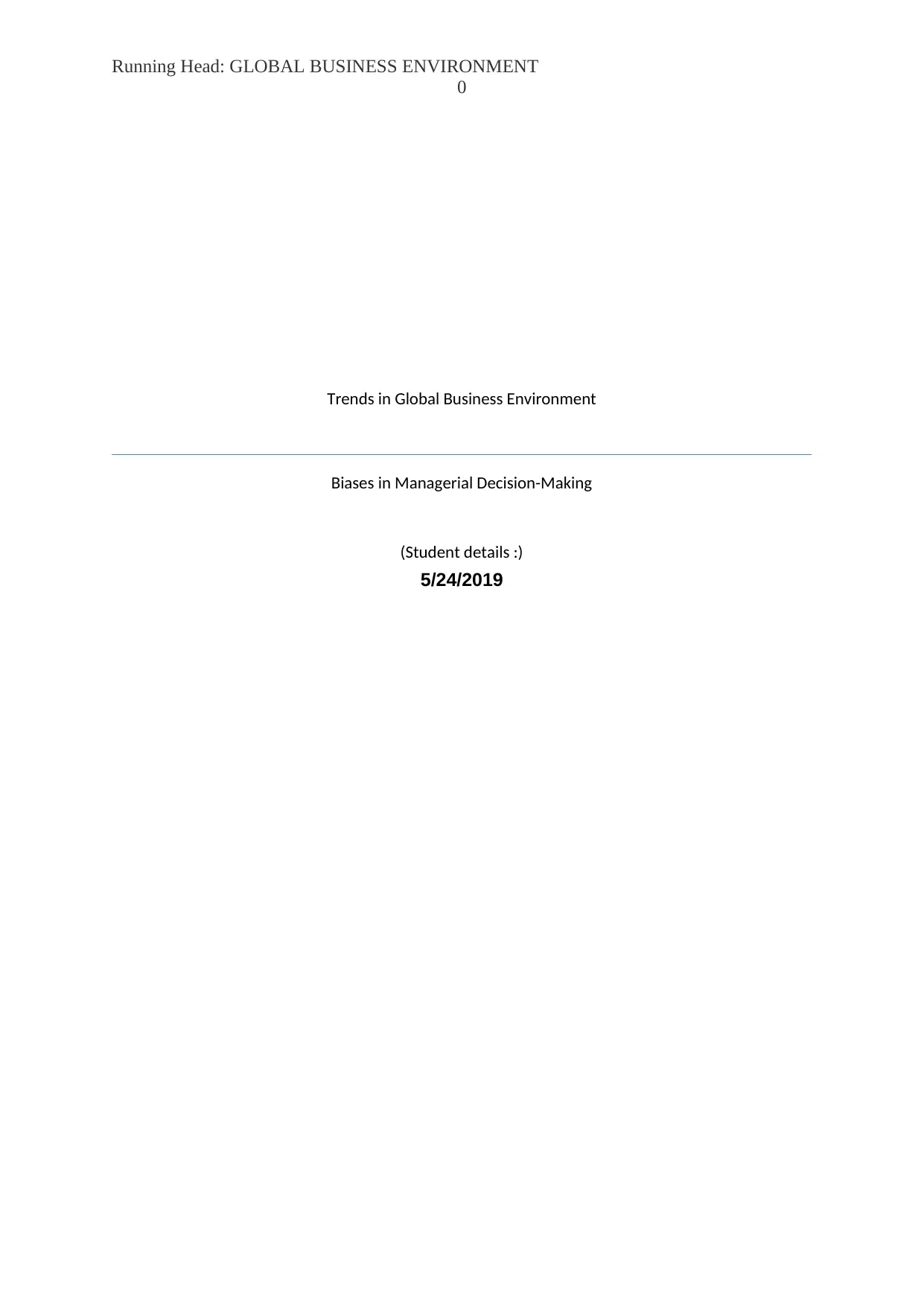
Running Head: GLOBAL BUSINESS ENVIRONMENT
0
Trends in Global Business Environment
Biases in Managerial Decision-Making
(Student details :)
5/24/2019
0
Trends in Global Business Environment
Biases in Managerial Decision-Making
(Student details :)
5/24/2019
Paraphrase This Document
Need a fresh take? Get an instant paraphrase of this document with our AI Paraphraser
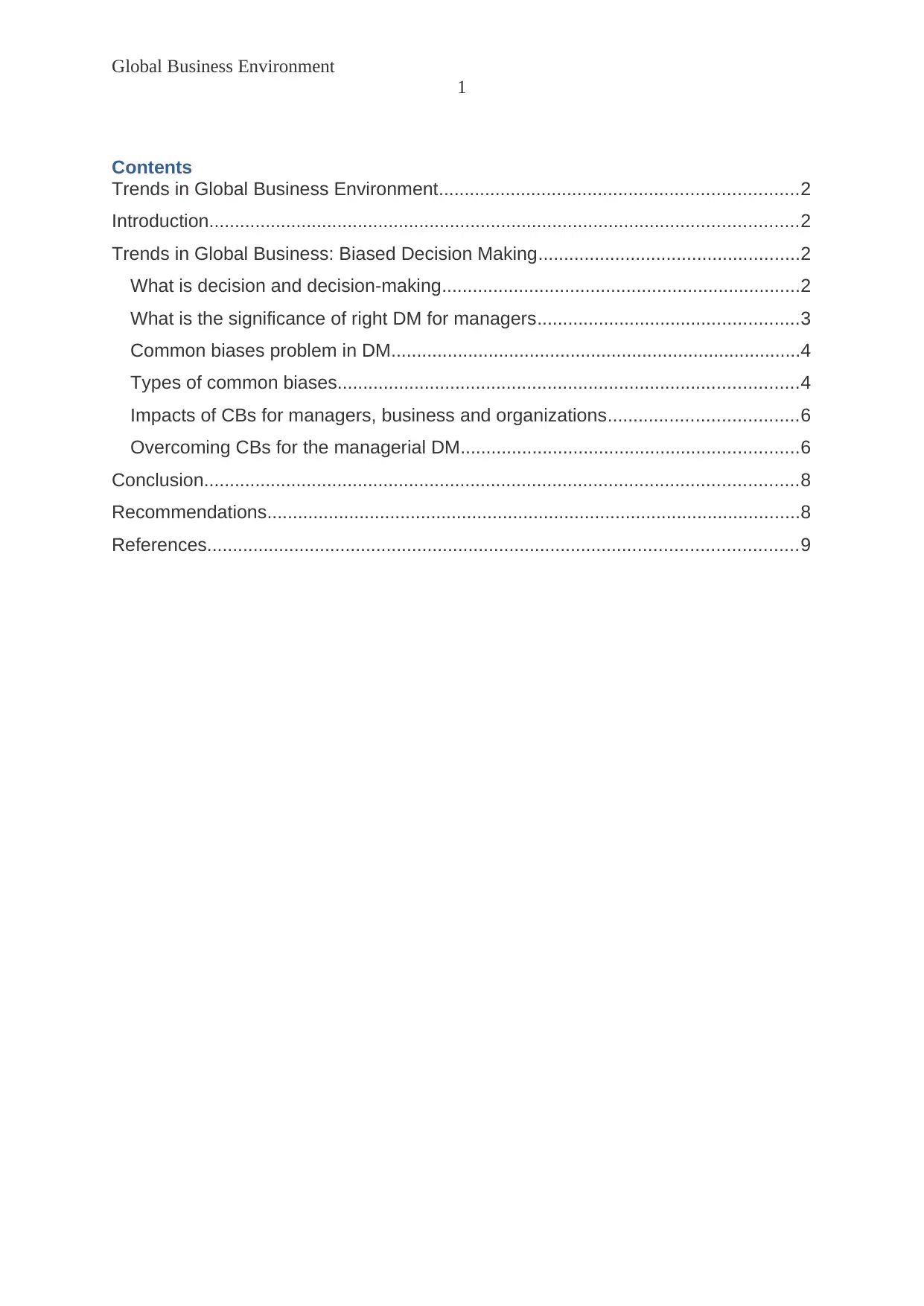
Global Business Environment
1
Contents
Trends in Global Business Environment......................................................................2
Introduction...................................................................................................................2
Trends in Global Business: Biased Decision Making...................................................2
What is decision and decision-making......................................................................2
What is the significance of right DM for managers...................................................3
Common biases problem in DM................................................................................4
Types of common biases..........................................................................................4
Impacts of CBs for managers, business and organizations.....................................6
Overcoming CBs for the managerial DM..................................................................6
Conclusion....................................................................................................................8
Recommendations........................................................................................................8
References...................................................................................................................9
1
Contents
Trends in Global Business Environment......................................................................2
Introduction...................................................................................................................2
Trends in Global Business: Biased Decision Making...................................................2
What is decision and decision-making......................................................................2
What is the significance of right DM for managers...................................................3
Common biases problem in DM................................................................................4
Types of common biases..........................................................................................4
Impacts of CBs for managers, business and organizations.....................................6
Overcoming CBs for the managerial DM..................................................................6
Conclusion....................................................................................................................8
Recommendations........................................................................................................8
References...................................................................................................................9
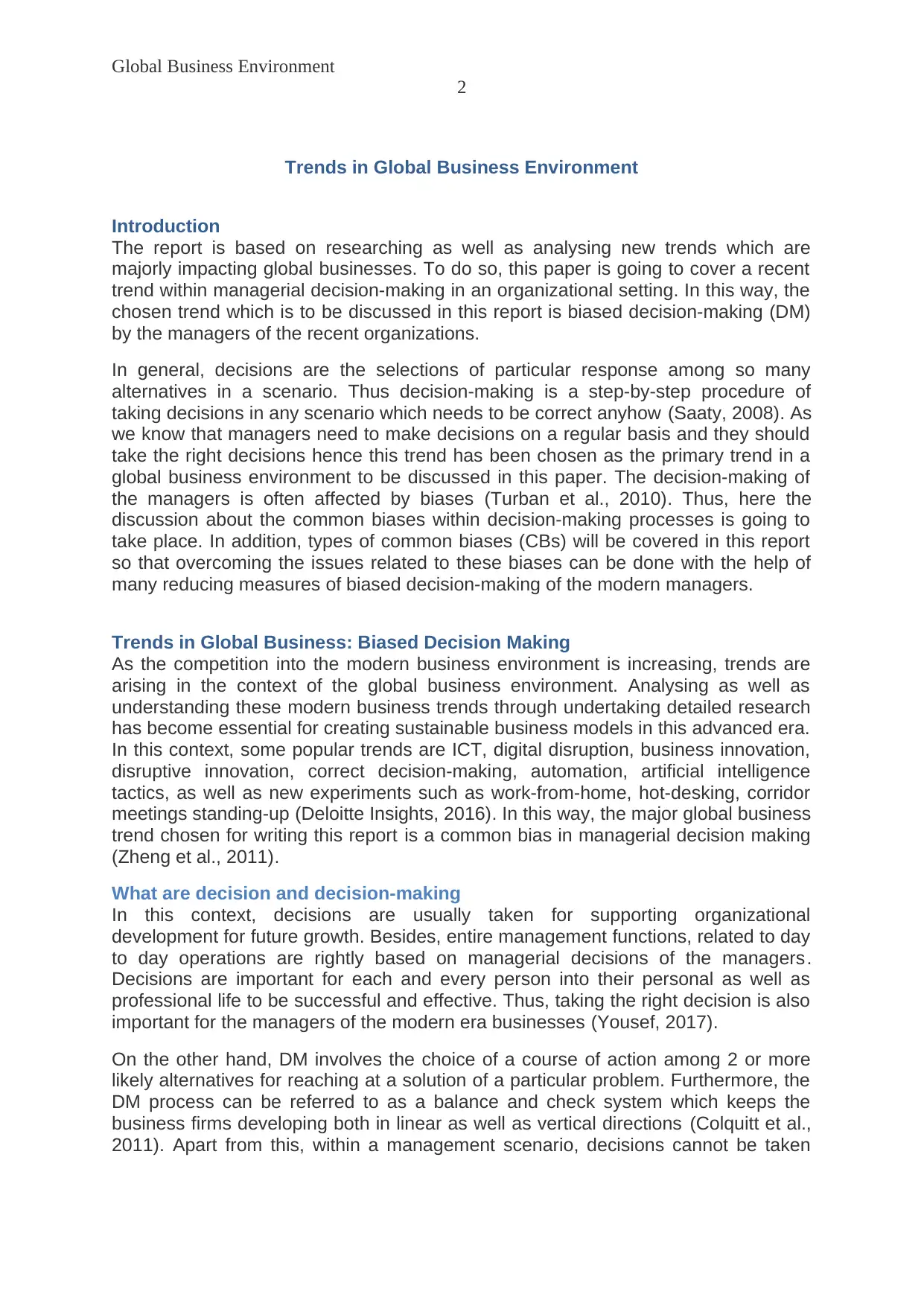
Global Business Environment
2
Trends in Global Business Environment
Introduction
The report is based on researching as well as analysing new trends which are
majorly impacting global businesses. To do so, this paper is going to cover a recent
trend within managerial decision-making in an organizational setting. In this way, the
chosen trend which is to be discussed in this report is biased decision-making (DM)
by the managers of the recent organizations.
In general, decisions are the selections of particular response among so many
alternatives in a scenario. Thus decision-making is a step-by-step procedure of
taking decisions in any scenario which needs to be correct anyhow (Saaty, 2008). As
we know that managers need to make decisions on a regular basis and they should
take the right decisions hence this trend has been chosen as the primary trend in a
global business environment to be discussed in this paper. The decision-making of
the managers is often affected by biases (Turban et al., 2010). Thus, here the
discussion about the common biases within decision-making processes is going to
take place. In addition, types of common biases (CBs) will be covered in this report
so that overcoming the issues related to these biases can be done with the help of
many reducing measures of biased decision-making of the modern managers.
Trends in Global Business: Biased Decision Making
As the competition into the modern business environment is increasing, trends are
arising in the context of the global business environment. Analysing as well as
understanding these modern business trends through undertaking detailed research
has become essential for creating sustainable business models in this advanced era.
In this context, some popular trends are ICT, digital disruption, business innovation,
disruptive innovation, correct decision-making, automation, artificial intelligence
tactics, as well as new experiments such as work-from-home, hot-desking, corridor
meetings standing-up (Deloitte Insights, 2016). In this way, the major global business
trend chosen for writing this report is a common bias in managerial decision making
(Zheng et al., 2011).
What are decision and decision-making
In this context, decisions are usually taken for supporting organizational
development for future growth. Besides, entire management functions, related to day
to day operations are rightly based on managerial decisions of the managers.
Decisions are important for each and every person into their personal as well as
professional life to be successful and effective. Thus, taking the right decision is also
important for the managers of the modern era businesses (Yousef, 2017).
On the other hand, DM involves the choice of a course of action among 2 or more
likely alternatives for reaching at a solution of a particular problem. Furthermore, the
DM process can be referred to as a balance and check system which keeps the
business firms developing both in linear as well as vertical directions (Colquitt et al.,
2011). Apart from this, within a management scenario, decisions cannot be taken
2
Trends in Global Business Environment
Introduction
The report is based on researching as well as analysing new trends which are
majorly impacting global businesses. To do so, this paper is going to cover a recent
trend within managerial decision-making in an organizational setting. In this way, the
chosen trend which is to be discussed in this report is biased decision-making (DM)
by the managers of the recent organizations.
In general, decisions are the selections of particular response among so many
alternatives in a scenario. Thus decision-making is a step-by-step procedure of
taking decisions in any scenario which needs to be correct anyhow (Saaty, 2008). As
we know that managers need to make decisions on a regular basis and they should
take the right decisions hence this trend has been chosen as the primary trend in a
global business environment to be discussed in this paper. The decision-making of
the managers is often affected by biases (Turban et al., 2010). Thus, here the
discussion about the common biases within decision-making processes is going to
take place. In addition, types of common biases (CBs) will be covered in this report
so that overcoming the issues related to these biases can be done with the help of
many reducing measures of biased decision-making of the modern managers.
Trends in Global Business: Biased Decision Making
As the competition into the modern business environment is increasing, trends are
arising in the context of the global business environment. Analysing as well as
understanding these modern business trends through undertaking detailed research
has become essential for creating sustainable business models in this advanced era.
In this context, some popular trends are ICT, digital disruption, business innovation,
disruptive innovation, correct decision-making, automation, artificial intelligence
tactics, as well as new experiments such as work-from-home, hot-desking, corridor
meetings standing-up (Deloitte Insights, 2016). In this way, the major global business
trend chosen for writing this report is a common bias in managerial decision making
(Zheng et al., 2011).
What are decision and decision-making
In this context, decisions are usually taken for supporting organizational
development for future growth. Besides, entire management functions, related to day
to day operations are rightly based on managerial decisions of the managers.
Decisions are important for each and every person into their personal as well as
professional life to be successful and effective. Thus, taking the right decision is also
important for the managers of the modern era businesses (Yousef, 2017).
On the other hand, DM involves the choice of a course of action among 2 or more
likely alternatives for reaching at a solution of a particular problem. Furthermore, the
DM process can be referred to as a balance and check system which keeps the
business firms developing both in linear as well as vertical directions (Colquitt et al.,
2011). Apart from this, within a management scenario, decisions cannot be taken
⊘ This is a preview!⊘
Do you want full access?
Subscribe today to unlock all pages.

Trusted by 1+ million students worldwide
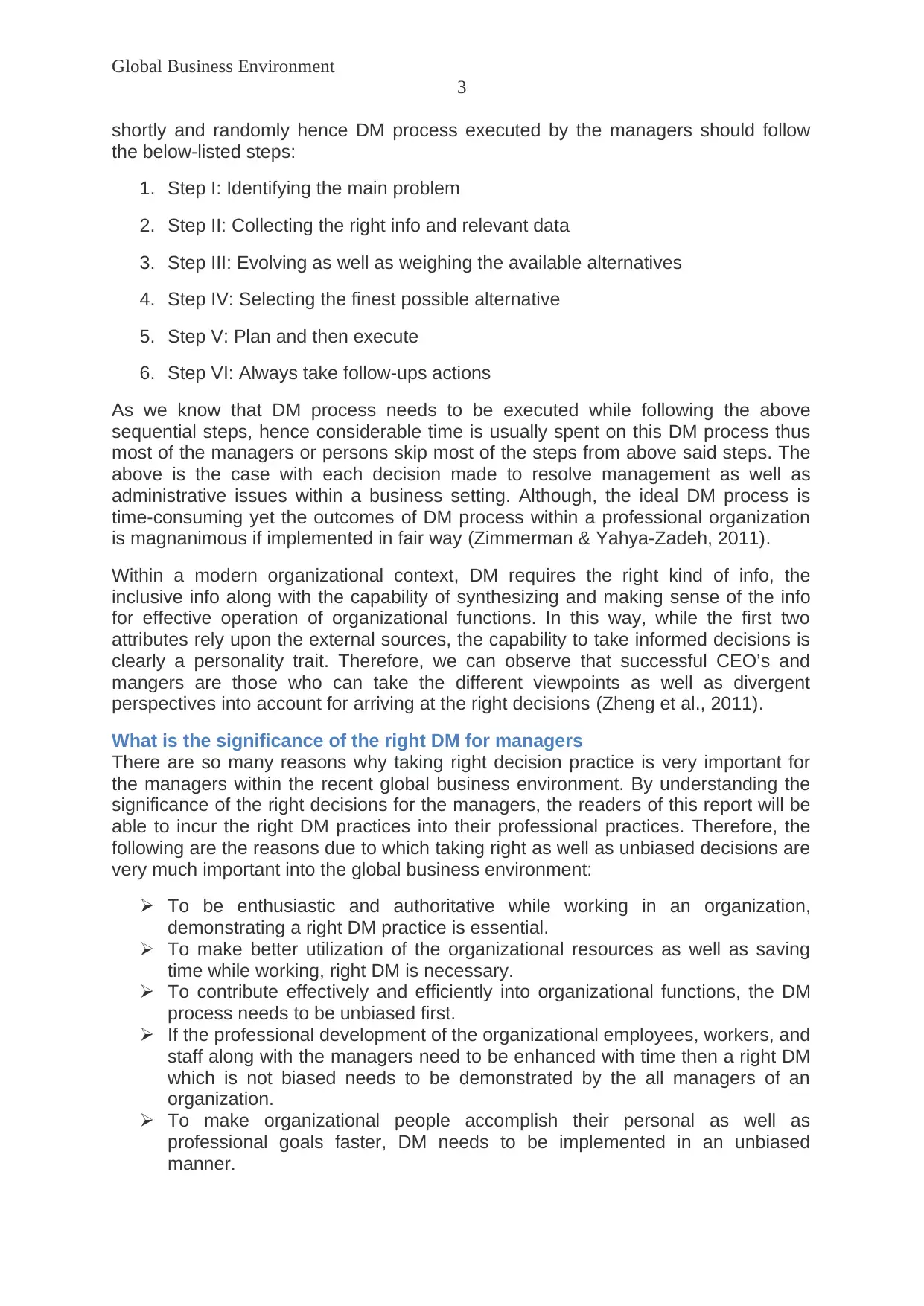
Global Business Environment
3
shortly and randomly hence DM process executed by the managers should follow
the below-listed steps:
1. Step I: Identifying the main problem
2. Step II: Collecting the right info and relevant data
3. Step III: Evolving as well as weighing the available alternatives
4. Step IV: Selecting the finest possible alternative
5. Step V: Plan and then execute
6. Step VI: Always take follow-ups actions
As we know that DM process needs to be executed while following the above
sequential steps, hence considerable time is usually spent on this DM process thus
most of the managers or persons skip most of the steps from above said steps. The
above is the case with each decision made to resolve management as well as
administrative issues within a business setting. Although, the ideal DM process is
time-consuming yet the outcomes of DM process within a professional organization
is magnanimous if implemented in fair way (Zimmerman & Yahya-Zadeh, 2011).
Within a modern organizational context, DM requires the right kind of info, the
inclusive info along with the capability of synthesizing and making sense of the info
for effective operation of organizational functions. In this way, while the first two
attributes rely upon the external sources, the capability to take informed decisions is
clearly a personality trait. Therefore, we can observe that successful CEO’s and
mangers are those who can take the different viewpoints as well as divergent
perspectives into account for arriving at the right decisions (Zheng et al., 2011).
What is the significance of the right DM for managers
There are so many reasons why taking right decision practice is very important for
the managers within the recent global business environment. By understanding the
significance of the right decisions for the managers, the readers of this report will be
able to incur the right DM practices into their professional practices. Therefore, the
following are the reasons due to which taking right as well as unbiased decisions are
very much important into the global business environment:
To be enthusiastic and authoritative while working in an organization,
demonstrating a right DM practice is essential.
To make better utilization of the organizational resources as well as saving
time while working, right DM is necessary.
To contribute effectively and efficiently into organizational functions, the DM
process needs to be unbiased first.
If the professional development of the organizational employees, workers, and
staff along with the managers need to be enhanced with time then a right DM
which is not biased needs to be demonstrated by the all managers of an
organization.
To make organizational people accomplish their personal as well as
professional goals faster, DM needs to be implemented in an unbiased
manner.
3
shortly and randomly hence DM process executed by the managers should follow
the below-listed steps:
1. Step I: Identifying the main problem
2. Step II: Collecting the right info and relevant data
3. Step III: Evolving as well as weighing the available alternatives
4. Step IV: Selecting the finest possible alternative
5. Step V: Plan and then execute
6. Step VI: Always take follow-ups actions
As we know that DM process needs to be executed while following the above
sequential steps, hence considerable time is usually spent on this DM process thus
most of the managers or persons skip most of the steps from above said steps. The
above is the case with each decision made to resolve management as well as
administrative issues within a business setting. Although, the ideal DM process is
time-consuming yet the outcomes of DM process within a professional organization
is magnanimous if implemented in fair way (Zimmerman & Yahya-Zadeh, 2011).
Within a modern organizational context, DM requires the right kind of info, the
inclusive info along with the capability of synthesizing and making sense of the info
for effective operation of organizational functions. In this way, while the first two
attributes rely upon the external sources, the capability to take informed decisions is
clearly a personality trait. Therefore, we can observe that successful CEO’s and
mangers are those who can take the different viewpoints as well as divergent
perspectives into account for arriving at the right decisions (Zheng et al., 2011).
What is the significance of the right DM for managers
There are so many reasons why taking right decision practice is very important for
the managers within the recent global business environment. By understanding the
significance of the right decisions for the managers, the readers of this report will be
able to incur the right DM practices into their professional practices. Therefore, the
following are the reasons due to which taking right as well as unbiased decisions are
very much important into the global business environment:
To be enthusiastic and authoritative while working in an organization,
demonstrating a right DM practice is essential.
To make better utilization of the organizational resources as well as saving
time while working, right DM is necessary.
To contribute effectively and efficiently into organizational functions, the DM
process needs to be unbiased first.
If the professional development of the organizational employees, workers, and
staff along with the managers need to be enhanced with time then a right DM
which is not biased needs to be demonstrated by the all managers of an
organization.
To make organizational people accomplish their personal as well as
professional goals faster, DM needs to be implemented in an unbiased
manner.
Paraphrase This Document
Need a fresh take? Get an instant paraphrase of this document with our AI Paraphraser
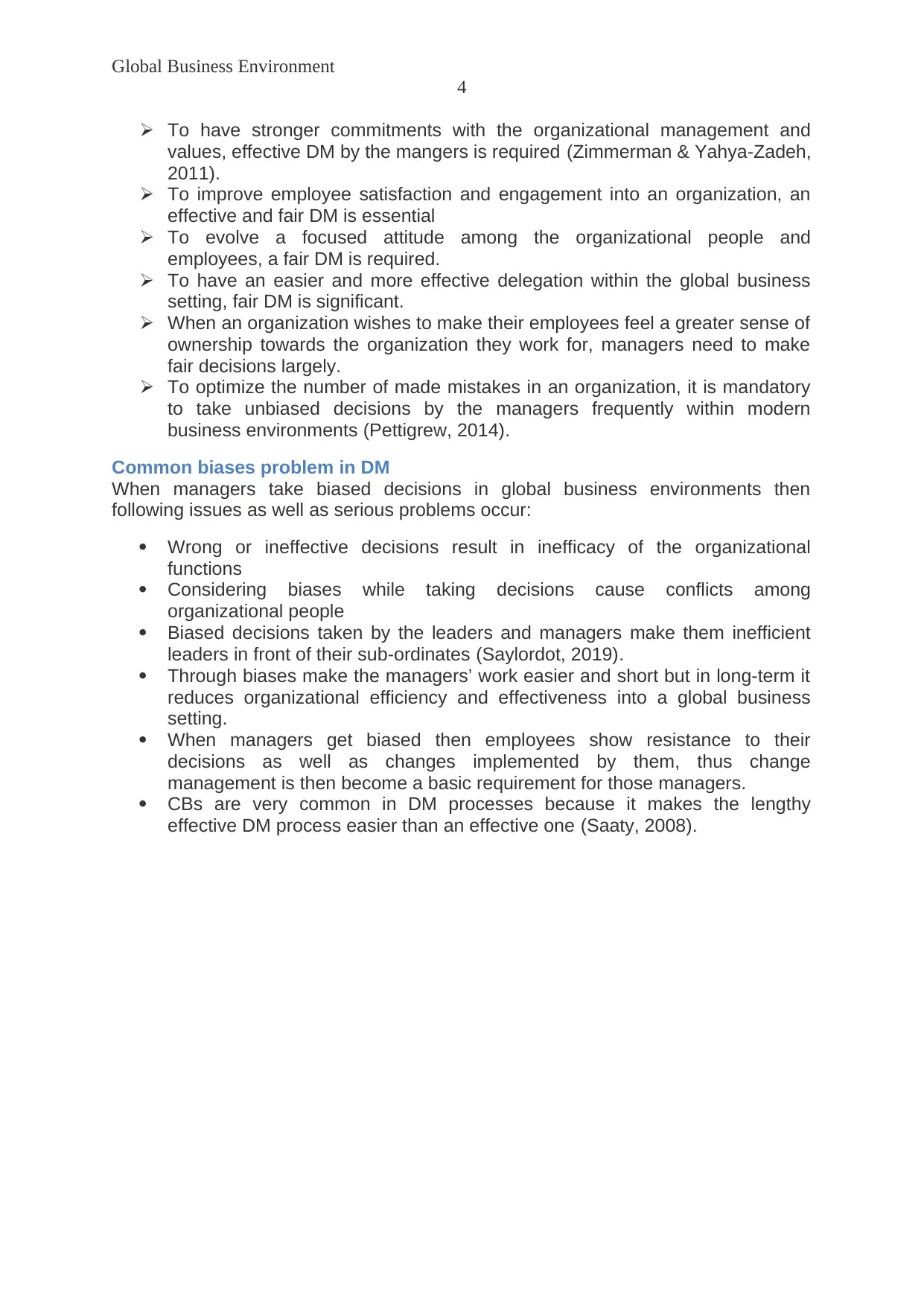
Global Business Environment
4
To have stronger commitments with the organizational management and
values, effective DM by the mangers is required (Zimmerman & Yahya-Zadeh,
2011).
To improve employee satisfaction and engagement into an organization, an
effective and fair DM is essential
To evolve a focused attitude among the organizational people and
employees, a fair DM is required.
To have an easier and more effective delegation within the global business
setting, fair DM is significant.
When an organization wishes to make their employees feel a greater sense of
ownership towards the organization they work for, managers need to make
fair decisions largely.
To optimize the number of made mistakes in an organization, it is mandatory
to take unbiased decisions by the managers frequently within modern
business environments (Pettigrew, 2014).
Common biases problem in DM
When managers take biased decisions in global business environments then
following issues as well as serious problems occur:
Wrong or ineffective decisions result in inefficacy of the organizational
functions
Considering biases while taking decisions cause conflicts among
organizational people
Biased decisions taken by the leaders and managers make them inefficient
leaders in front of their sub-ordinates (Saylordot, 2019).
Through biases make the managers’ work easier and short but in long-term it
reduces organizational efficiency and effectiveness into a global business
setting.
When managers get biased then employees show resistance to their
decisions as well as changes implemented by them, thus change
management is then become a basic requirement for those managers.
CBs are very common in DM processes because it makes the lengthy
effective DM process easier than an effective one (Saaty, 2008).
4
To have stronger commitments with the organizational management and
values, effective DM by the mangers is required (Zimmerman & Yahya-Zadeh,
2011).
To improve employee satisfaction and engagement into an organization, an
effective and fair DM is essential
To evolve a focused attitude among the organizational people and
employees, a fair DM is required.
To have an easier and more effective delegation within the global business
setting, fair DM is significant.
When an organization wishes to make their employees feel a greater sense of
ownership towards the organization they work for, managers need to make
fair decisions largely.
To optimize the number of made mistakes in an organization, it is mandatory
to take unbiased decisions by the managers frequently within modern
business environments (Pettigrew, 2014).
Common biases problem in DM
When managers take biased decisions in global business environments then
following issues as well as serious problems occur:
Wrong or ineffective decisions result in inefficacy of the organizational
functions
Considering biases while taking decisions cause conflicts among
organizational people
Biased decisions taken by the leaders and managers make them inefficient
leaders in front of their sub-ordinates (Saylordot, 2019).
Through biases make the managers’ work easier and short but in long-term it
reduces organizational efficiency and effectiveness into a global business
setting.
When managers get biased then employees show resistance to their
decisions as well as changes implemented by them, thus change
management is then become a basic requirement for those managers.
CBs are very common in DM processes because it makes the lengthy
effective DM process easier than an effective one (Saaty, 2008).
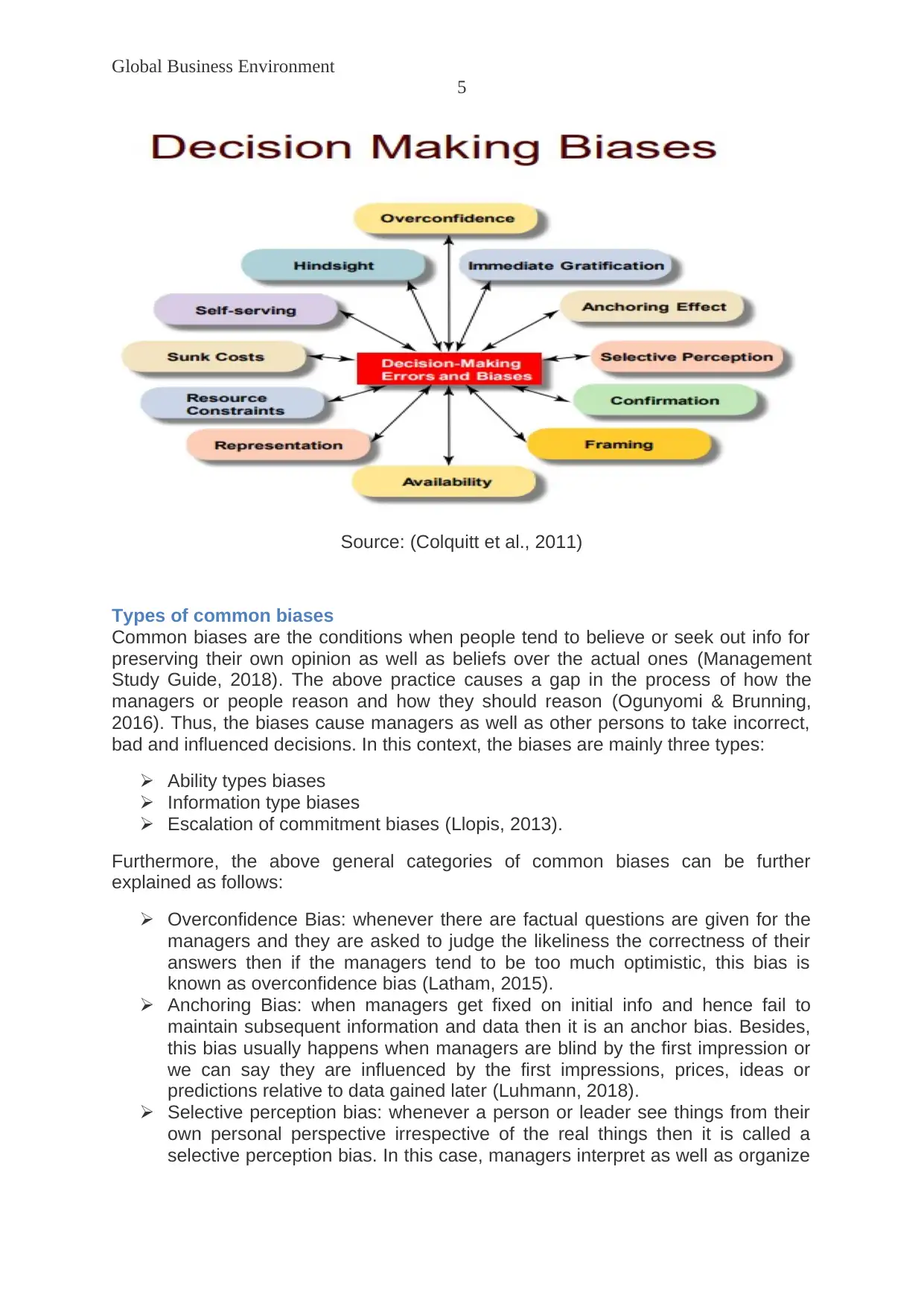
Global Business Environment
5
Source: (Colquitt et al., 2011)
Types of common biases
Common biases are the conditions when people tend to believe or seek out info for
preserving their own opinion as well as beliefs over the actual ones (Management
Study Guide, 2018). The above practice causes a gap in the process of how the
managers or people reason and how they should reason (Ogunyomi & Brunning,
2016). Thus, the biases cause managers as well as other persons to take incorrect,
bad and influenced decisions. In this context, the biases are mainly three types:
Ability types biases
Information type biases
Escalation of commitment biases (Llopis, 2013).
Furthermore, the above general categories of common biases can be further
explained as follows:
Overconfidence Bias: whenever there are factual questions are given for the
managers and they are asked to judge the likeliness the correctness of their
answers then if the managers tend to be too much optimistic, this bias is
known as overconfidence bias (Latham, 2015).
Anchoring Bias: when managers get fixed on initial info and hence fail to
maintain subsequent information and data then it is an anchor bias. Besides,
this bias usually happens when managers are blind by the first impression or
we can say they are influenced by the first impressions, prices, ideas or
predictions relative to data gained later (Luhmann, 2018).
Selective perception bias: whenever a person or leader see things from their
own personal perspective irrespective of the real things then it is called a
selective perception bias. In this case, managers interpret as well as organize
5
Source: (Colquitt et al., 2011)
Types of common biases
Common biases are the conditions when people tend to believe or seek out info for
preserving their own opinion as well as beliefs over the actual ones (Management
Study Guide, 2018). The above practice causes a gap in the process of how the
managers or people reason and how they should reason (Ogunyomi & Brunning,
2016). Thus, the biases cause managers as well as other persons to take incorrect,
bad and influenced decisions. In this context, the biases are mainly three types:
Ability types biases
Information type biases
Escalation of commitment biases (Llopis, 2013).
Furthermore, the above general categories of common biases can be further
explained as follows:
Overconfidence Bias: whenever there are factual questions are given for the
managers and they are asked to judge the likeliness the correctness of their
answers then if the managers tend to be too much optimistic, this bias is
known as overconfidence bias (Latham, 2015).
Anchoring Bias: when managers get fixed on initial info and hence fail to
maintain subsequent information and data then it is an anchor bias. Besides,
this bias usually happens when managers are blind by the first impression or
we can say they are influenced by the first impressions, prices, ideas or
predictions relative to data gained later (Luhmann, 2018).
Selective perception bias: whenever a person or leader see things from their
own personal perspective irrespective of the real things then it is called a
selective perception bias. In this case, managers interpret as well as organize
⊘ This is a preview!⊘
Do you want full access?
Subscribe today to unlock all pages.

Trusted by 1+ million students worldwide
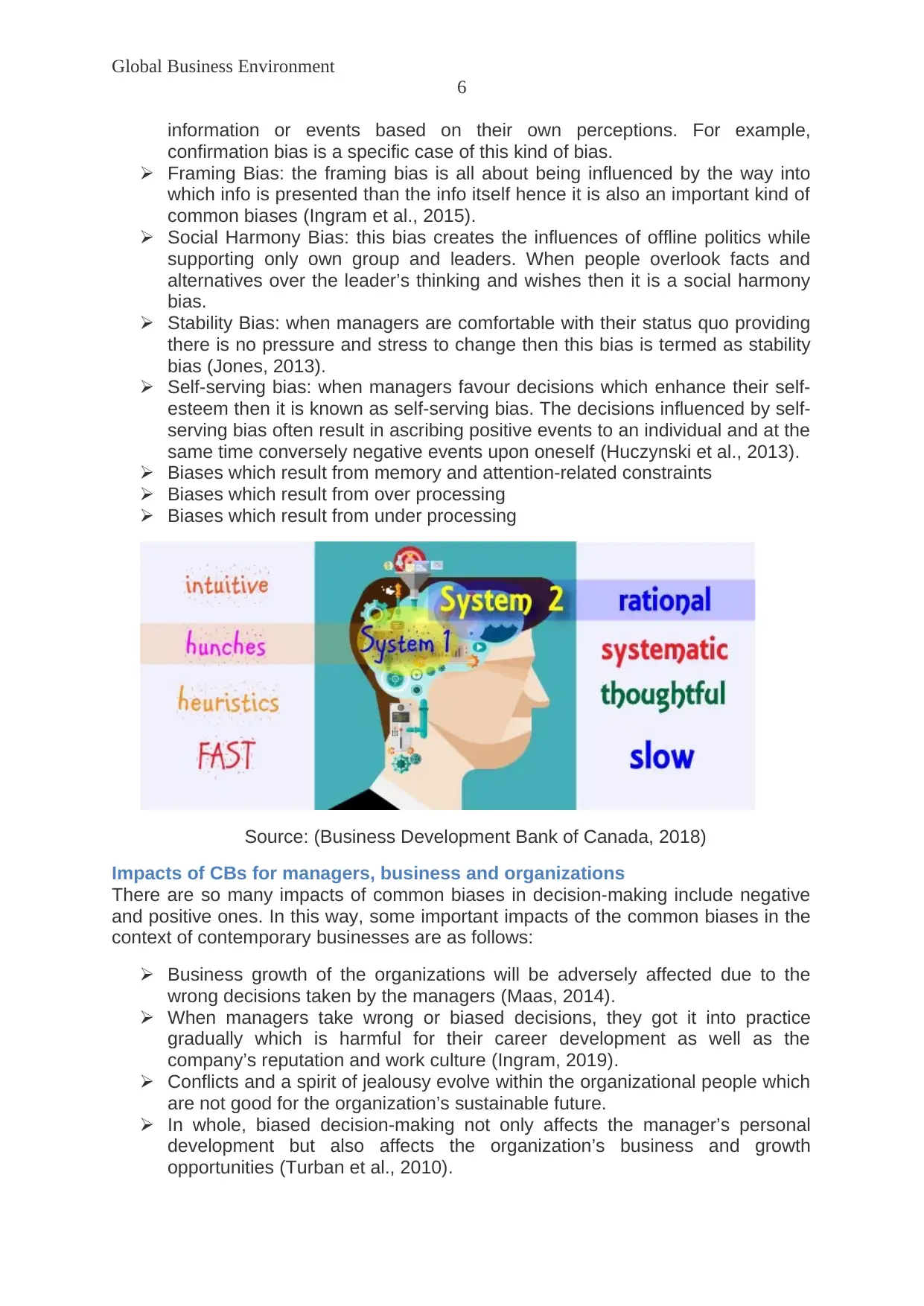
Global Business Environment
6
information or events based on their own perceptions. For example,
confirmation bias is a specific case of this kind of bias.
Framing Bias: the framing bias is all about being influenced by the way into
which info is presented than the info itself hence it is also an important kind of
common biases (Ingram et al., 2015).
Social Harmony Bias: this bias creates the influences of offline politics while
supporting only own group and leaders. When people overlook facts and
alternatives over the leader’s thinking and wishes then it is a social harmony
bias.
Stability Bias: when managers are comfortable with their status quo providing
there is no pressure and stress to change then this bias is termed as stability
bias (Jones, 2013).
Self-serving bias: when managers favour decisions which enhance their self-
esteem then it is known as self-serving bias. The decisions influenced by self-
serving bias often result in ascribing positive events to an individual and at the
same time conversely negative events upon oneself (Huczynski et al., 2013).
Biases which result from memory and attention-related constraints
Biases which result from over processing
Biases which result from under processing
Source: (Business Development Bank of Canada, 2018)
Impacts of CBs for managers, business and organizations
There are so many impacts of common biases in decision-making include negative
and positive ones. In this way, some important impacts of the common biases in the
context of contemporary businesses are as follows:
Business growth of the organizations will be adversely affected due to the
wrong decisions taken by the managers (Maas, 2014).
When managers take wrong or biased decisions, they got it into practice
gradually which is harmful for their career development as well as the
company’s reputation and work culture (Ingram, 2019).
Conflicts and a spirit of jealousy evolve within the organizational people which
are not good for the organization’s sustainable future.
In whole, biased decision-making not only affects the manager’s personal
development but also affects the organization’s business and growth
opportunities (Turban et al., 2010).
6
information or events based on their own perceptions. For example,
confirmation bias is a specific case of this kind of bias.
Framing Bias: the framing bias is all about being influenced by the way into
which info is presented than the info itself hence it is also an important kind of
common biases (Ingram et al., 2015).
Social Harmony Bias: this bias creates the influences of offline politics while
supporting only own group and leaders. When people overlook facts and
alternatives over the leader’s thinking and wishes then it is a social harmony
bias.
Stability Bias: when managers are comfortable with their status quo providing
there is no pressure and stress to change then this bias is termed as stability
bias (Jones, 2013).
Self-serving bias: when managers favour decisions which enhance their self-
esteem then it is known as self-serving bias. The decisions influenced by self-
serving bias often result in ascribing positive events to an individual and at the
same time conversely negative events upon oneself (Huczynski et al., 2013).
Biases which result from memory and attention-related constraints
Biases which result from over processing
Biases which result from under processing
Source: (Business Development Bank of Canada, 2018)
Impacts of CBs for managers, business and organizations
There are so many impacts of common biases in decision-making include negative
and positive ones. In this way, some important impacts of the common biases in the
context of contemporary businesses are as follows:
Business growth of the organizations will be adversely affected due to the
wrong decisions taken by the managers (Maas, 2014).
When managers take wrong or biased decisions, they got it into practice
gradually which is harmful for their career development as well as the
company’s reputation and work culture (Ingram, 2019).
Conflicts and a spirit of jealousy evolve within the organizational people which
are not good for the organization’s sustainable future.
In whole, biased decision-making not only affects the manager’s personal
development but also affects the organization’s business and growth
opportunities (Turban et al., 2010).
Paraphrase This Document
Need a fresh take? Get an instant paraphrase of this document with our AI Paraphraser
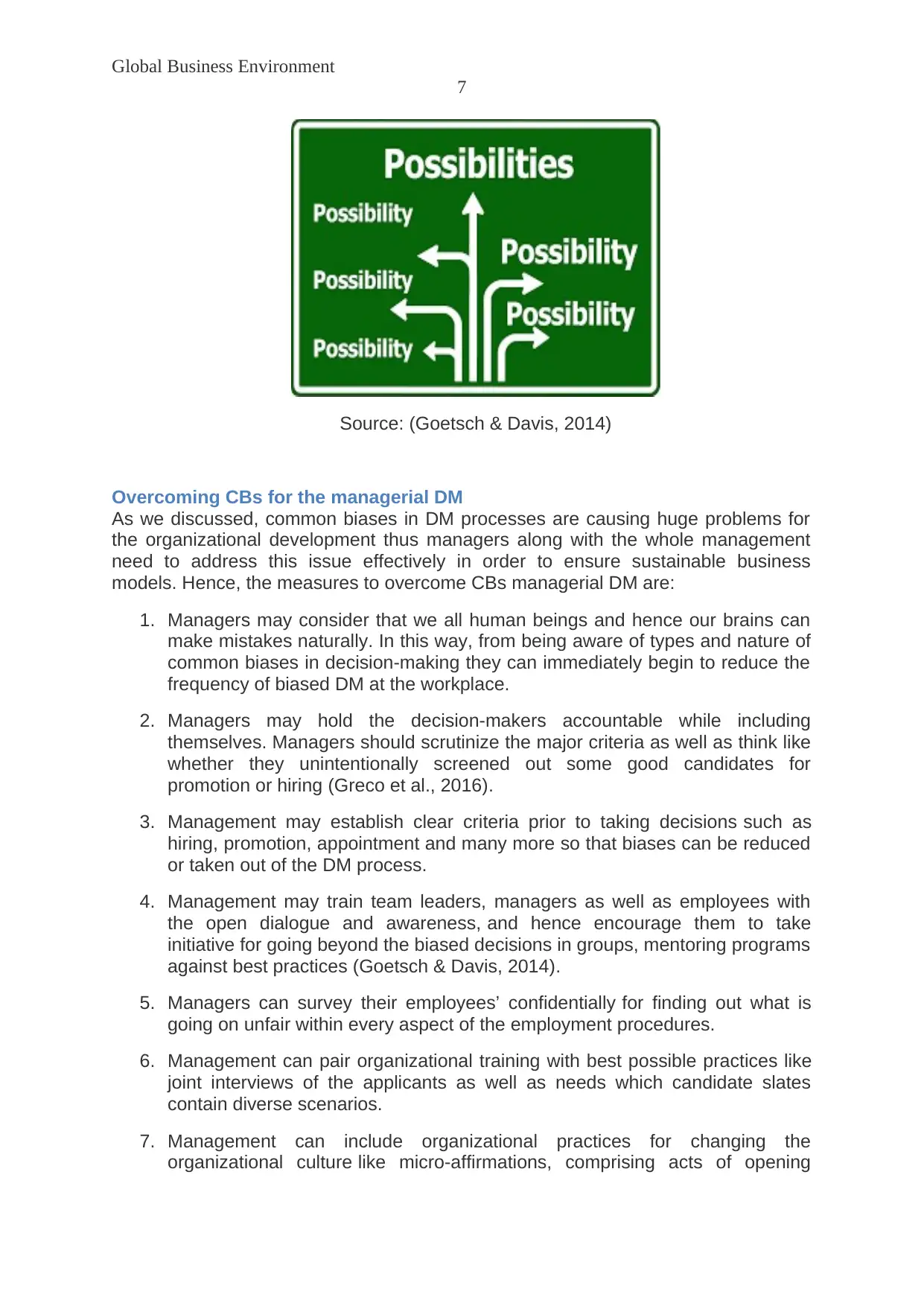
Global Business Environment
7
Source: (Goetsch & Davis, 2014)
Overcoming CBs for the managerial DM
As we discussed, common biases in DM processes are causing huge problems for
the organizational development thus managers along with the whole management
need to address this issue effectively in order to ensure sustainable business
models. Hence, the measures to overcome CBs managerial DM are:
1. Managers may consider that we all human beings and hence our brains can
make mistakes naturally. In this way, from being aware of types and nature of
common biases in decision-making they can immediately begin to reduce the
frequency of biased DM at the workplace.
2. Managers may hold the decision-makers accountable while including
themselves. Managers should scrutinize the major criteria as well as think like
whether they unintentionally screened out some good candidates for
promotion or hiring (Greco et al., 2016).
3. Management may establish clear criteria prior to taking decisions such as
hiring, promotion, appointment and many more so that biases can be reduced
or taken out of the DM process.
4. Management may train team leaders, managers as well as employees with
the open dialogue and awareness, and hence encourage them to take
initiative for going beyond the biased decisions in groups, mentoring programs
against best practices (Goetsch & Davis, 2014).
5. Managers can survey their employees’ confidentially for finding out what is
going on unfair within every aspect of the employment procedures.
6. Management can pair organizational training with best possible practices like
joint interviews of the applicants as well as needs which candidate slates
contain diverse scenarios.
7. Management can include organizational practices for changing the
organizational culture like micro-affirmations, comprising acts of opening
7
Source: (Goetsch & Davis, 2014)
Overcoming CBs for the managerial DM
As we discussed, common biases in DM processes are causing huge problems for
the organizational development thus managers along with the whole management
need to address this issue effectively in order to ensure sustainable business
models. Hence, the measures to overcome CBs managerial DM are:
1. Managers may consider that we all human beings and hence our brains can
make mistakes naturally. In this way, from being aware of types and nature of
common biases in decision-making they can immediately begin to reduce the
frequency of biased DM at the workplace.
2. Managers may hold the decision-makers accountable while including
themselves. Managers should scrutinize the major criteria as well as think like
whether they unintentionally screened out some good candidates for
promotion or hiring (Greco et al., 2016).
3. Management may establish clear criteria prior to taking decisions such as
hiring, promotion, appointment and many more so that biases can be reduced
or taken out of the DM process.
4. Management may train team leaders, managers as well as employees with
the open dialogue and awareness, and hence encourage them to take
initiative for going beyond the biased decisions in groups, mentoring programs
against best practices (Goetsch & Davis, 2014).
5. Managers can survey their employees’ confidentially for finding out what is
going on unfair within every aspect of the employment procedures.
6. Management can pair organizational training with best possible practices like
joint interviews of the applicants as well as needs which candidate slates
contain diverse scenarios.
7. Management can include organizational practices for changing the
organizational culture like micro-affirmations, comprising acts of opening
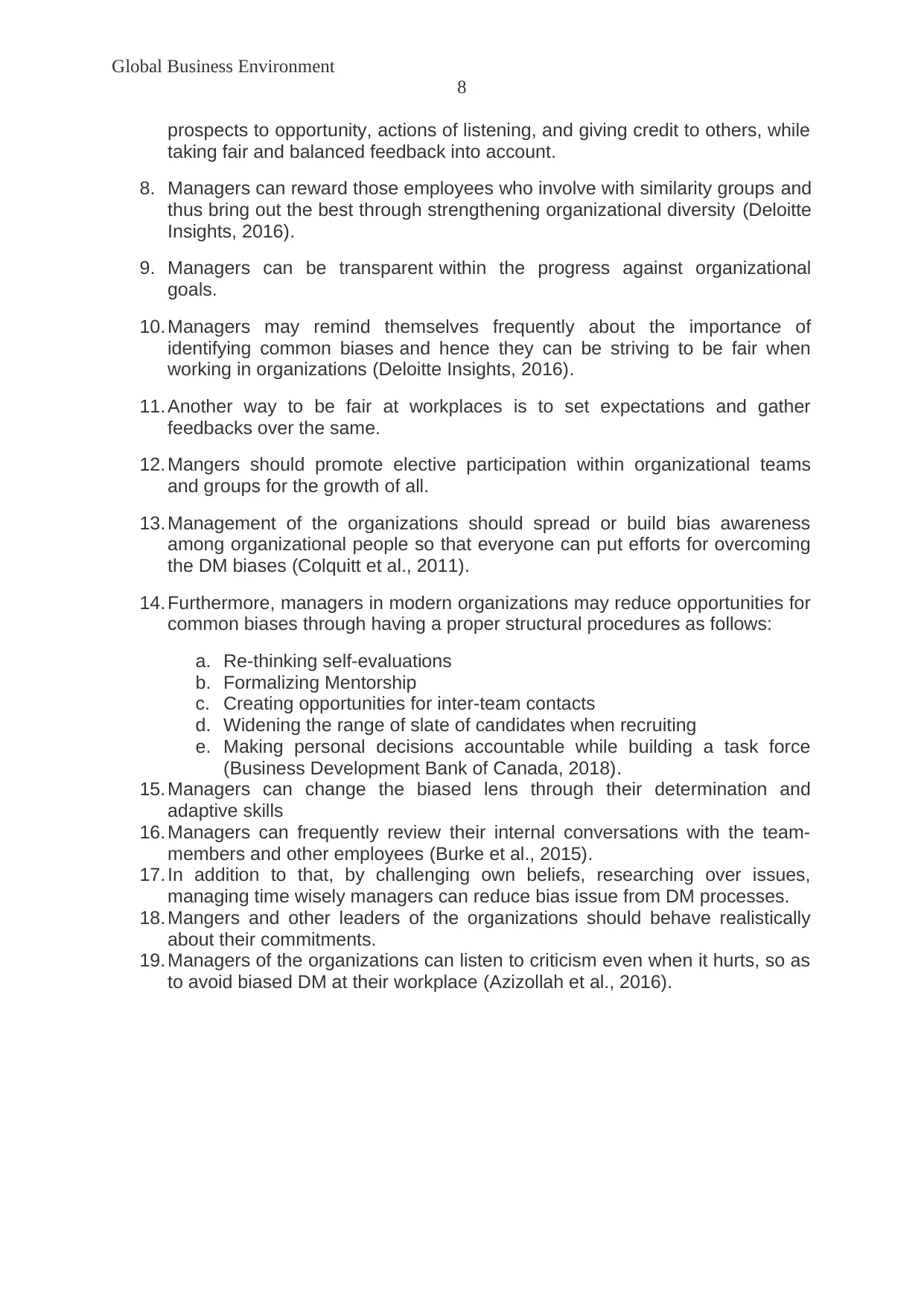
Global Business Environment
8
prospects to opportunity, actions of listening, and giving credit to others, while
taking fair and balanced feedback into account.
8. Managers can reward those employees who involve with similarity groups and
thus bring out the best through strengthening organizational diversity (Deloitte
Insights, 2016).
9. Managers can be transparent within the progress against organizational
goals.
10. Managers may remind themselves frequently about the importance of
identifying common biases and hence they can be striving to be fair when
working in organizations (Deloitte Insights, 2016).
11. Another way to be fair at workplaces is to set expectations and gather
feedbacks over the same.
12. Mangers should promote elective participation within organizational teams
and groups for the growth of all.
13. Management of the organizations should spread or build bias awareness
among organizational people so that everyone can put efforts for overcoming
the DM biases (Colquitt et al., 2011).
14. Furthermore, managers in modern organizations may reduce opportunities for
common biases through having a proper structural procedures as follows:
a. Re-thinking self-evaluations
b. Formalizing Mentorship
c. Creating opportunities for inter-team contacts
d. Widening the range of slate of candidates when recruiting
e. Making personal decisions accountable while building a task force
(Business Development Bank of Canada, 2018).
15. Managers can change the biased lens through their determination and
adaptive skills
16. Managers can frequently review their internal conversations with the team-
members and other employees (Burke et al., 2015).
17. In addition to that, by challenging own beliefs, researching over issues,
managing time wisely managers can reduce bias issue from DM processes.
18. Mangers and other leaders of the organizations should behave realistically
about their commitments.
19. Managers of the organizations can listen to criticism even when it hurts, so as
to avoid biased DM at their workplace (Azizollah et al., 2016).
8
prospects to opportunity, actions of listening, and giving credit to others, while
taking fair and balanced feedback into account.
8. Managers can reward those employees who involve with similarity groups and
thus bring out the best through strengthening organizational diversity (Deloitte
Insights, 2016).
9. Managers can be transparent within the progress against organizational
goals.
10. Managers may remind themselves frequently about the importance of
identifying common biases and hence they can be striving to be fair when
working in organizations (Deloitte Insights, 2016).
11. Another way to be fair at workplaces is to set expectations and gather
feedbacks over the same.
12. Mangers should promote elective participation within organizational teams
and groups for the growth of all.
13. Management of the organizations should spread or build bias awareness
among organizational people so that everyone can put efforts for overcoming
the DM biases (Colquitt et al., 2011).
14. Furthermore, managers in modern organizations may reduce opportunities for
common biases through having a proper structural procedures as follows:
a. Re-thinking self-evaluations
b. Formalizing Mentorship
c. Creating opportunities for inter-team contacts
d. Widening the range of slate of candidates when recruiting
e. Making personal decisions accountable while building a task force
(Business Development Bank of Canada, 2018).
15. Managers can change the biased lens through their determination and
adaptive skills
16. Managers can frequently review their internal conversations with the team-
members and other employees (Burke et al., 2015).
17. In addition to that, by challenging own beliefs, researching over issues,
managing time wisely managers can reduce bias issue from DM processes.
18. Mangers and other leaders of the organizations should behave realistically
about their commitments.
19. Managers of the organizations can listen to criticism even when it hurts, so as
to avoid biased DM at their workplace (Azizollah et al., 2016).
⊘ This is a preview!⊘
Do you want full access?
Subscribe today to unlock all pages.

Trusted by 1+ million students worldwide
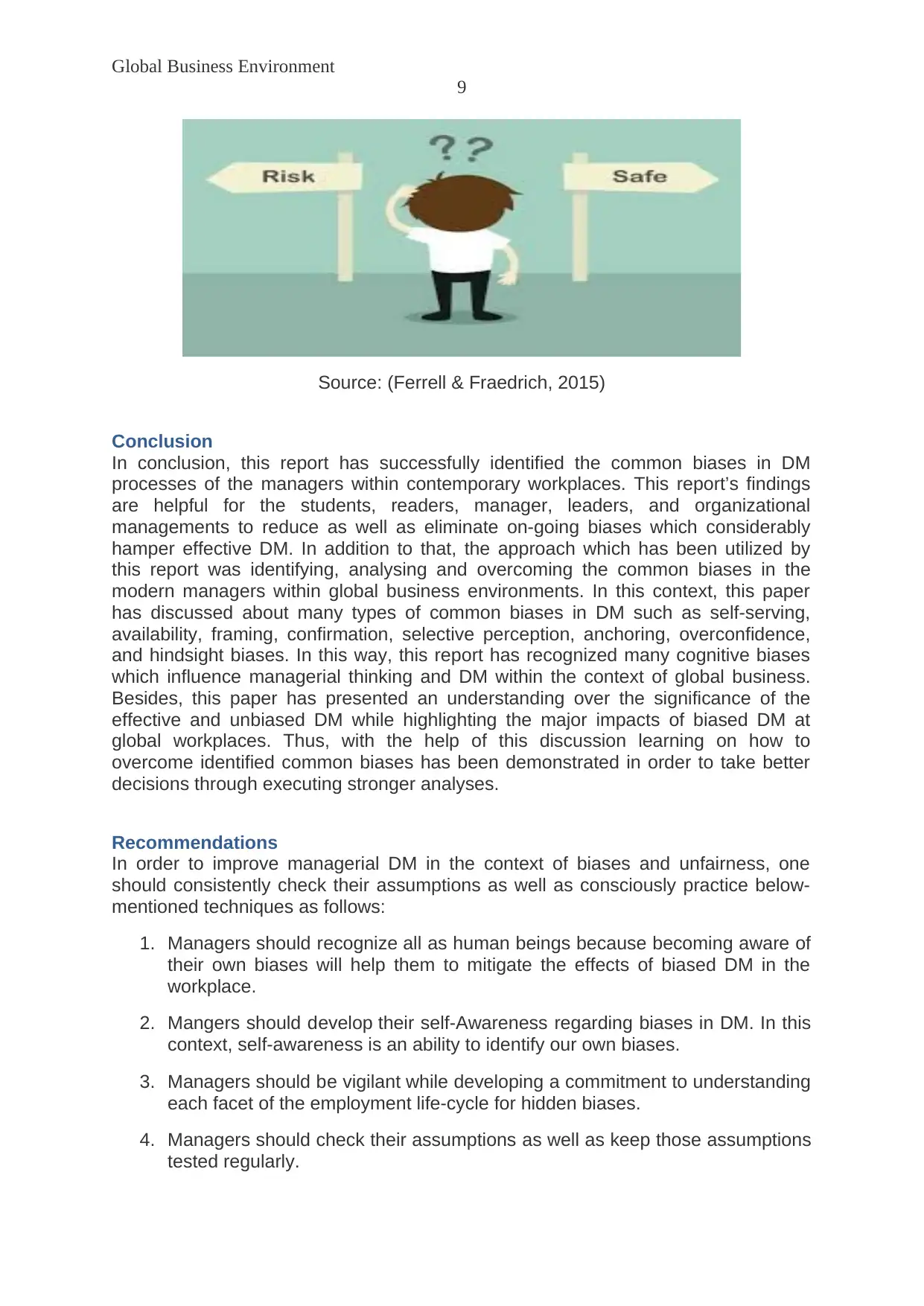
Global Business Environment
9
Source: (Ferrell & Fraedrich, 2015)
Conclusion
In conclusion, this report has successfully identified the common biases in DM
processes of the managers within contemporary workplaces. This report’s findings
are helpful for the students, readers, manager, leaders, and organizational
managements to reduce as well as eliminate on-going biases which considerably
hamper effective DM. In addition to that, the approach which has been utilized by
this report was identifying, analysing and overcoming the common biases in the
modern managers within global business environments. In this context, this paper
has discussed about many types of common biases in DM such as self-serving,
availability, framing, confirmation, selective perception, anchoring, overconfidence,
and hindsight biases. In this way, this report has recognized many cognitive biases
which influence managerial thinking and DM within the context of global business.
Besides, this paper has presented an understanding over the significance of the
effective and unbiased DM while highlighting the major impacts of biased DM at
global workplaces. Thus, with the help of this discussion learning on how to
overcome identified common biases has been demonstrated in order to take better
decisions through executing stronger analyses.
Recommendations
In order to improve managerial DM in the context of biases and unfairness, one
should consistently check their assumptions as well as consciously practice below-
mentioned techniques as follows:
1. Managers should recognize all as human beings because becoming aware of
their own biases will help them to mitigate the effects of biased DM in the
workplace.
2. Mangers should develop their self-Awareness regarding biases in DM. In this
context, self-awareness is an ability to identify our own biases.
3. Managers should be vigilant while developing a commitment to understanding
each facet of the employment life-cycle for hidden biases.
4. Managers should check their assumptions as well as keep those assumptions
tested regularly.
9
Source: (Ferrell & Fraedrich, 2015)
Conclusion
In conclusion, this report has successfully identified the common biases in DM
processes of the managers within contemporary workplaces. This report’s findings
are helpful for the students, readers, manager, leaders, and organizational
managements to reduce as well as eliminate on-going biases which considerably
hamper effective DM. In addition to that, the approach which has been utilized by
this report was identifying, analysing and overcoming the common biases in the
modern managers within global business environments. In this context, this paper
has discussed about many types of common biases in DM such as self-serving,
availability, framing, confirmation, selective perception, anchoring, overconfidence,
and hindsight biases. In this way, this report has recognized many cognitive biases
which influence managerial thinking and DM within the context of global business.
Besides, this paper has presented an understanding over the significance of the
effective and unbiased DM while highlighting the major impacts of biased DM at
global workplaces. Thus, with the help of this discussion learning on how to
overcome identified common biases has been demonstrated in order to take better
decisions through executing stronger analyses.
Recommendations
In order to improve managerial DM in the context of biases and unfairness, one
should consistently check their assumptions as well as consciously practice below-
mentioned techniques as follows:
1. Managers should recognize all as human beings because becoming aware of
their own biases will help them to mitigate the effects of biased DM in the
workplace.
2. Mangers should develop their self-Awareness regarding biases in DM. In this
context, self-awareness is an ability to identify our own biases.
3. Managers should be vigilant while developing a commitment to understanding
each facet of the employment life-cycle for hidden biases.
4. Managers should check their assumptions as well as keep those assumptions
tested regularly.
Paraphrase This Document
Need a fresh take? Get an instant paraphrase of this document with our AI Paraphraser
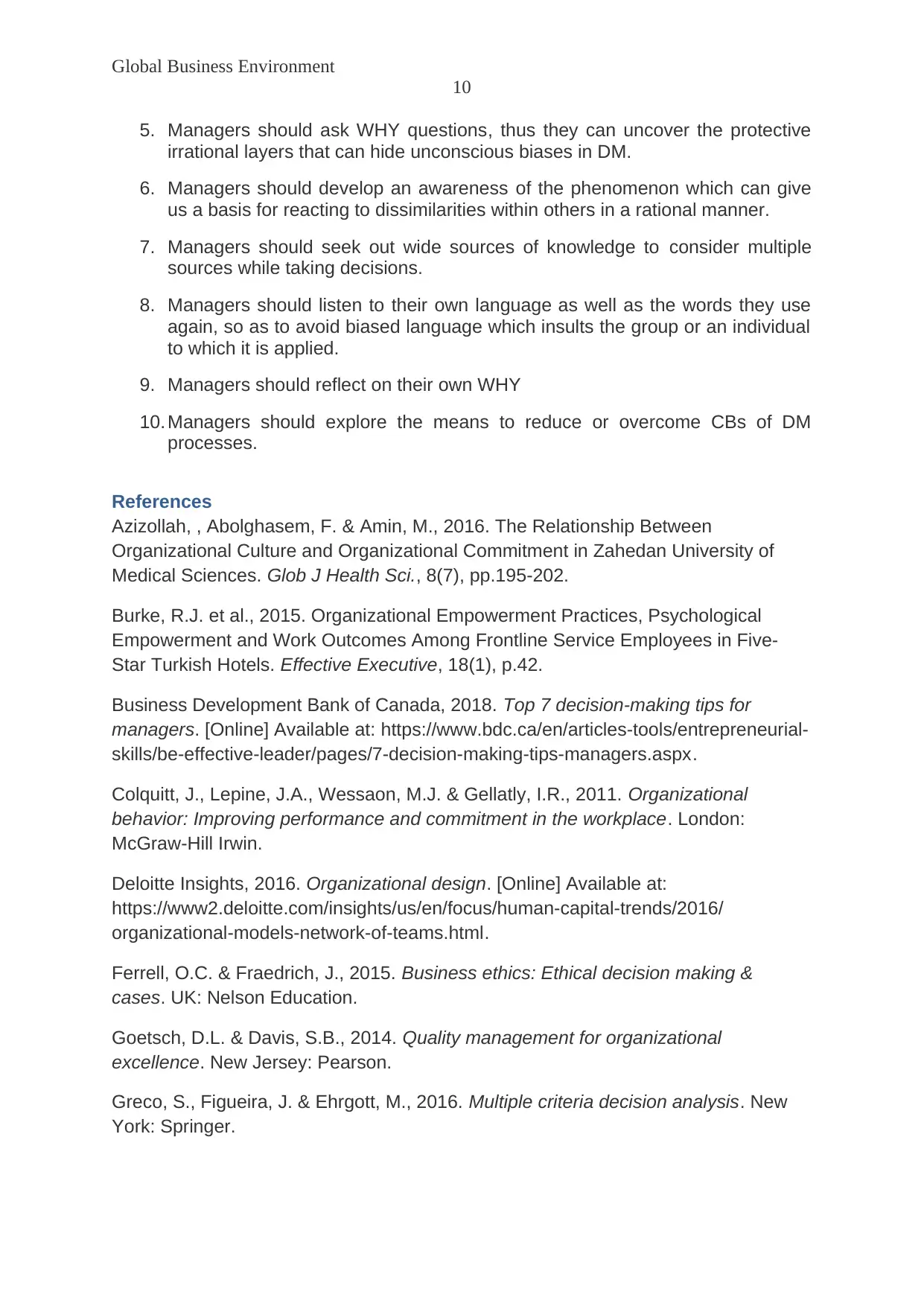
Global Business Environment
10
5. Managers should ask WHY questions, thus they can uncover the protective
irrational layers that can hide unconscious biases in DM.
6. Managers should develop an awareness of the phenomenon which can give
us a basis for reacting to dissimilarities within others in a rational manner.
7. Managers should seek out wide sources of knowledge to consider multiple
sources while taking decisions.
8. Managers should listen to their own language as well as the words they use
again, so as to avoid biased language which insults the group or an individual
to which it is applied.
9. Managers should reflect on their own WHY
10. Managers should explore the means to reduce or overcome CBs of DM
processes.
References
Azizollah, , Abolghasem, F. & Amin, M., 2016. The Relationship Between
Organizational Culture and Organizational Commitment in Zahedan University of
Medical Sciences. Glob J Health Sci., 8(7), pp.195-202.
Burke, R.J. et al., 2015. Organizational Empowerment Practices, Psychological
Empowerment and Work Outcomes Among Frontline Service Employees in Five-
Star Turkish Hotels. Effective Executive, 18(1), p.42.
Business Development Bank of Canada, 2018. Top 7 decision-making tips for
managers. [Online] Available at: https://www.bdc.ca/en/articles-tools/entrepreneurial-
skills/be-effective-leader/pages/7-decision-making-tips-managers.aspx.
Colquitt, J., Lepine, J.A., Wessaon, M.J. & Gellatly, I.R., 2011. Organizational
behavior: Improving performance and commitment in the workplace. London:
McGraw-Hill Irwin.
Deloitte Insights, 2016. Organizational design. [Online] Available at:
https://www2.deloitte.com/insights/us/en/focus/human-capital-trends/2016/
organizational-models-network-of-teams.html.
Ferrell, O.C. & Fraedrich, J., 2015. Business ethics: Ethical decision making &
cases. UK: Nelson Education.
Goetsch, D.L. & Davis, S.B., 2014. Quality management for organizational
excellence. New Jersey: Pearson.
Greco, S., Figueira, J. & Ehrgott, M., 2016. Multiple criteria decision analysis. New
York: Springer.
10
5. Managers should ask WHY questions, thus they can uncover the protective
irrational layers that can hide unconscious biases in DM.
6. Managers should develop an awareness of the phenomenon which can give
us a basis for reacting to dissimilarities within others in a rational manner.
7. Managers should seek out wide sources of knowledge to consider multiple
sources while taking decisions.
8. Managers should listen to their own language as well as the words they use
again, so as to avoid biased language which insults the group or an individual
to which it is applied.
9. Managers should reflect on their own WHY
10. Managers should explore the means to reduce or overcome CBs of DM
processes.
References
Azizollah, , Abolghasem, F. & Amin, M., 2016. The Relationship Between
Organizational Culture and Organizational Commitment in Zahedan University of
Medical Sciences. Glob J Health Sci., 8(7), pp.195-202.
Burke, R.J. et al., 2015. Organizational Empowerment Practices, Psychological
Empowerment and Work Outcomes Among Frontline Service Employees in Five-
Star Turkish Hotels. Effective Executive, 18(1), p.42.
Business Development Bank of Canada, 2018. Top 7 decision-making tips for
managers. [Online] Available at: https://www.bdc.ca/en/articles-tools/entrepreneurial-
skills/be-effective-leader/pages/7-decision-making-tips-managers.aspx.
Colquitt, J., Lepine, J.A., Wessaon, M.J. & Gellatly, I.R., 2011. Organizational
behavior: Improving performance and commitment in the workplace. London:
McGraw-Hill Irwin.
Deloitte Insights, 2016. Organizational design. [Online] Available at:
https://www2.deloitte.com/insights/us/en/focus/human-capital-trends/2016/
organizational-models-network-of-teams.html.
Ferrell, O.C. & Fraedrich, J., 2015. Business ethics: Ethical decision making &
cases. UK: Nelson Education.
Goetsch, D.L. & Davis, S.B., 2014. Quality management for organizational
excellence. New Jersey: Pearson.
Greco, S., Figueira, J. & Ehrgott, M., 2016. Multiple criteria decision analysis. New
York: Springer.
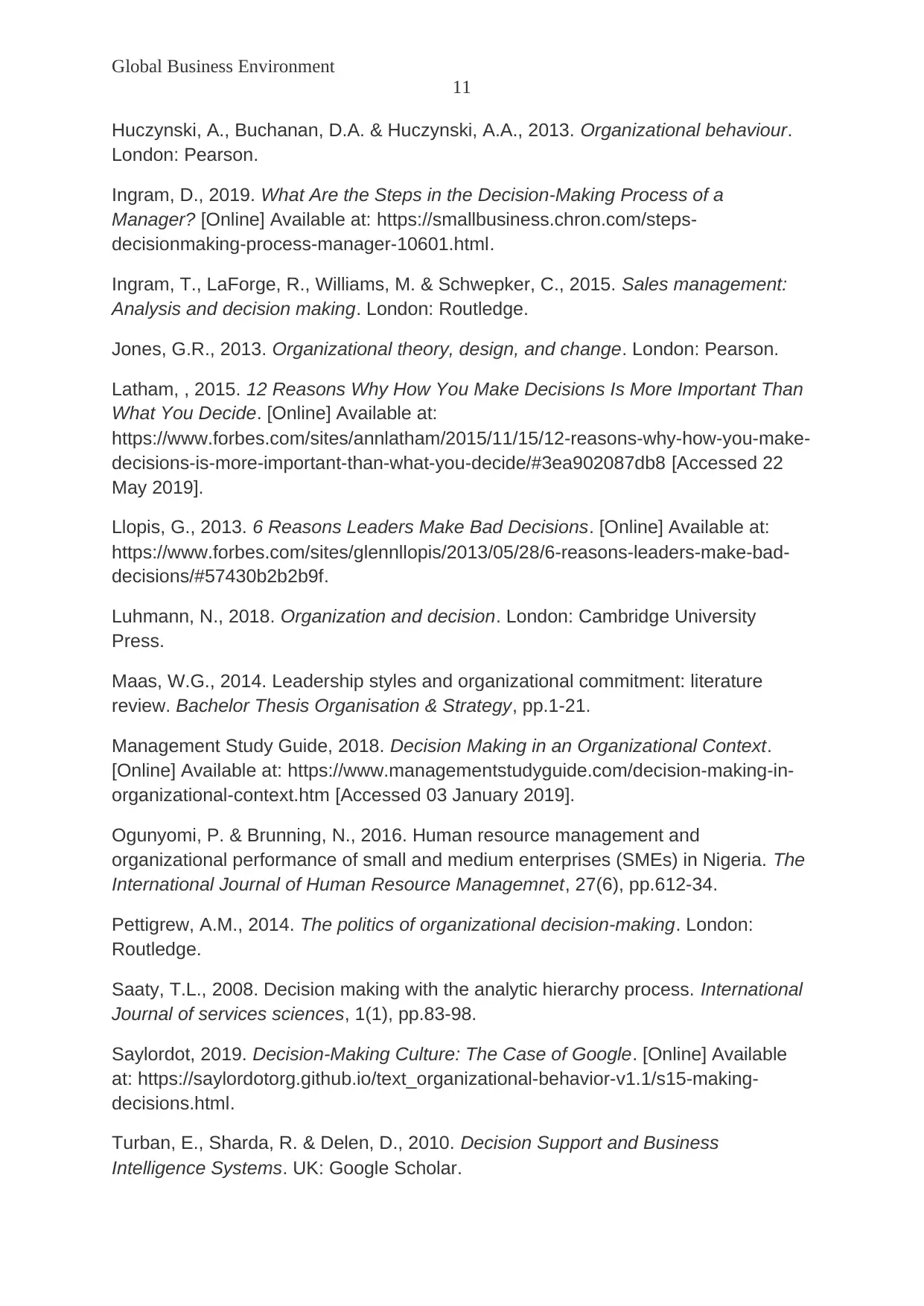
Global Business Environment
11
Huczynski, A., Buchanan, D.A. & Huczynski, A.A., 2013. Organizational behaviour.
London: Pearson.
Ingram, D., 2019. What Are the Steps in the Decision-Making Process of a
Manager? [Online] Available at: https://smallbusiness.chron.com/steps-
decisionmaking-process-manager-10601.html.
Ingram, T., LaForge, R., Williams, M. & Schwepker, C., 2015. Sales management:
Analysis and decision making. London: Routledge.
Jones, G.R., 2013. Organizational theory, design, and change. London: Pearson.
Latham, , 2015. 12 Reasons Why How You Make Decisions Is More Important Than
What You Decide. [Online] Available at:
https://www.forbes.com/sites/annlatham/2015/11/15/12-reasons-why-how-you-make-
decisions-is-more-important-than-what-you-decide/#3ea902087db8 [Accessed 22
May 2019].
Llopis, G., 2013. 6 Reasons Leaders Make Bad Decisions. [Online] Available at:
https://www.forbes.com/sites/glennllopis/2013/05/28/6-reasons-leaders-make-bad-
decisions/#57430b2b2b9f.
Luhmann, N., 2018. Organization and decision. London: Cambridge University
Press.
Maas, W.G., 2014. Leadership styles and organizational commitment: literature
review. Bachelor Thesis Organisation & Strategy, pp.1-21.
Management Study Guide, 2018. Decision Making in an Organizational Context.
[Online] Available at: https://www.managementstudyguide.com/decision-making-in-
organizational-context.htm [Accessed 03 January 2019].
Ogunyomi, P. & Brunning, N., 2016. Human resource management and
organizational performance of small and medium enterprises (SMEs) in Nigeria. The
International Journal of Human Resource Managemnet, 27(6), pp.612-34.
Pettigrew, A.M., 2014. The politics of organizational decision-making. London:
Routledge.
Saaty, T.L., 2008. Decision making with the analytic hierarchy process. International
Journal of services sciences, 1(1), pp.83-98.
Saylordot, 2019. Decision-Making Culture: The Case of Google. [Online] Available
at: https://saylordotorg.github.io/text_organizational-behavior-v1.1/s15-making-
decisions.html.
Turban, E., Sharda, R. & Delen, D., 2010. Decision Support and Business
Intelligence Systems. UK: Google Scholar.
11
Huczynski, A., Buchanan, D.A. & Huczynski, A.A., 2013. Organizational behaviour.
London: Pearson.
Ingram, D., 2019. What Are the Steps in the Decision-Making Process of a
Manager? [Online] Available at: https://smallbusiness.chron.com/steps-
decisionmaking-process-manager-10601.html.
Ingram, T., LaForge, R., Williams, M. & Schwepker, C., 2015. Sales management:
Analysis and decision making. London: Routledge.
Jones, G.R., 2013. Organizational theory, design, and change. London: Pearson.
Latham, , 2015. 12 Reasons Why How You Make Decisions Is More Important Than
What You Decide. [Online] Available at:
https://www.forbes.com/sites/annlatham/2015/11/15/12-reasons-why-how-you-make-
decisions-is-more-important-than-what-you-decide/#3ea902087db8 [Accessed 22
May 2019].
Llopis, G., 2013. 6 Reasons Leaders Make Bad Decisions. [Online] Available at:
https://www.forbes.com/sites/glennllopis/2013/05/28/6-reasons-leaders-make-bad-
decisions/#57430b2b2b9f.
Luhmann, N., 2018. Organization and decision. London: Cambridge University
Press.
Maas, W.G., 2014. Leadership styles and organizational commitment: literature
review. Bachelor Thesis Organisation & Strategy, pp.1-21.
Management Study Guide, 2018. Decision Making in an Organizational Context.
[Online] Available at: https://www.managementstudyguide.com/decision-making-in-
organizational-context.htm [Accessed 03 January 2019].
Ogunyomi, P. & Brunning, N., 2016. Human resource management and
organizational performance of small and medium enterprises (SMEs) in Nigeria. The
International Journal of Human Resource Managemnet, 27(6), pp.612-34.
Pettigrew, A.M., 2014. The politics of organizational decision-making. London:
Routledge.
Saaty, T.L., 2008. Decision making with the analytic hierarchy process. International
Journal of services sciences, 1(1), pp.83-98.
Saylordot, 2019. Decision-Making Culture: The Case of Google. [Online] Available
at: https://saylordotorg.github.io/text_organizational-behavior-v1.1/s15-making-
decisions.html.
Turban, E., Sharda, R. & Delen, D., 2010. Decision Support and Business
Intelligence Systems. UK: Google Scholar.
⊘ This is a preview!⊘
Do you want full access?
Subscribe today to unlock all pages.

Trusted by 1+ million students worldwide
1 out of 13
Related Documents
Your All-in-One AI-Powered Toolkit for Academic Success.
+13062052269
info@desklib.com
Available 24*7 on WhatsApp / Email
![[object Object]](/_next/static/media/star-bottom.7253800d.svg)
Unlock your academic potential
Copyright © 2020–2025 A2Z Services. All Rights Reserved. Developed and managed by ZUCOL.




